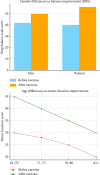Exploring the Role of Frenkel Exercises in Enhancing Dynamic Balance and Motor Function in the Aged With Neurological Disorders: A Systematic Review
- PMID: 40552169
- PMCID: PMC12185199
- DOI: 10.1155/jare/8814069
Exploring the Role of Frenkel Exercises in Enhancing Dynamic Balance and Motor Function in the Aged With Neurological Disorders: A Systematic Review
Abstract
Background: The increasing prevalence of neurological conditions in older adults leads to impaired balance and mobility, heightening fall risk. This systematic review explores the effectiveness of Frenkel exercises in enhancing dynamic balance and motor function, underscoring the importance of fall prevention techniques supported by evidence. Methods: This systematic review adhered to Preferred Reporting Items for Systematic Reviews and Meta-Analyses (PRISMA) guidelines, including studies published from 2020 to 2025. Researchers utilized various databases, including MEDLINE/PubMed, Web of Science, APA PsycNet, Science Direct, Scopus, the Cochrane Library, and Google Scholar, to identify pertinent articles. Studies were selected based on inclusion criteria for individuals aged 65 years and above with neurological disorders. The primary outcomes assessed were dynamic balance and motor function, with secondary outcomes including fall risk. Results: Six studies, encompassing 198 participants, were included in this review. They demonstrated significant improvements in dynamic balance and motor function following Frenkel exercise interventions. Five studies reported enhanced balance, measured by the Berg Balance Scale and timed up and go test. Frenkel exercises also contributed to a reduced fall risk and improved mobility. Consistent with other studies, our results show that Frenkel exercises effectively boost self-confidence and physical function. Conclusion: Frenkel exercises improve dynamic balance and motor function while lowering fall risk in elderly individuals with neurological disorders. Its simplicity and low cost make it a practical option, but more long-term studies are needed to confirm these benefits.
Keywords: elderly; exercise therapy; fall prevention; postural balance; rehabilitation.
Copyright © 2025 Alireza Vasiee et al. Journal of Aging Research published by John Wiley & Sons Ltd.
Conflict of interest statement
The authors declare no conflicts of interest.
Figures





Similar articles
-
Home treatment for mental health problems: a systematic review.Health Technol Assess. 2001;5(15):1-139. doi: 10.3310/hta5150. Health Technol Assess. 2001. PMID: 11532236
-
Antidepressants for pain management in adults with chronic pain: a network meta-analysis.Health Technol Assess. 2024 Oct;28(62):1-155. doi: 10.3310/MKRT2948. Health Technol Assess. 2024. PMID: 39367772 Free PMC article.
-
Interventions for promoting habitual exercise in people living with and beyond cancer.Cochrane Database Syst Rev. 2018 Sep 19;9(9):CD010192. doi: 10.1002/14651858.CD010192.pub3. Cochrane Database Syst Rev. 2018. PMID: 30229557 Free PMC article.
-
Physical activity and exercise for chronic pain in adults: an overview of Cochrane Reviews.Cochrane Database Syst Rev. 2017 Jan 14;1(1):CD011279. doi: 10.1002/14651858.CD011279.pub2. Cochrane Database Syst Rev. 2017. Update in: Cochrane Database Syst Rev. 2017 Apr 24;4:CD011279. doi: 10.1002/14651858.CD011279.pub3. PMID: 28087891 Free PMC article. Updated.
-
Systemic pharmacological treatments for chronic plaque psoriasis: a network meta-analysis.Cochrane Database Syst Rev. 2021 Apr 19;4(4):CD011535. doi: 10.1002/14651858.CD011535.pub4. Cochrane Database Syst Rev. 2021. Update in: Cochrane Database Syst Rev. 2022 May 23;5:CD011535. doi: 10.1002/14651858.CD011535.pub5. PMID: 33871055 Free PMC article. Updated.
References
-
- Park C., Atique M. M. U., Mishra R., Najafi B. Association Between Fall History and Gait, Balance, Physical Activity, Depression, Fear of Falling, and Motor Capacity: A 6-Month Follow-Up Study. International Journal of Environmental Research and Public Health . 2022;19(17):p. 10785. doi: 10.3390/ijerph191710785. - DOI - PMC - PubMed
-
- Rodniam J., Thiamwong L. Falls, Fear of Falling, Daily Activities, and Quality of Life in Thai Community-Dwelling Older Adults. Innovation in Aging . 2023;7(Supplement_1):p. 239. doi: 10.1093/geroni/igad104.0784. - DOI
Publication types
LinkOut - more resources
Full Text Sources

